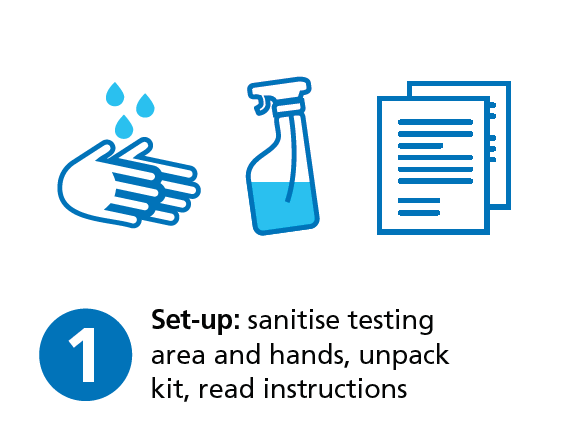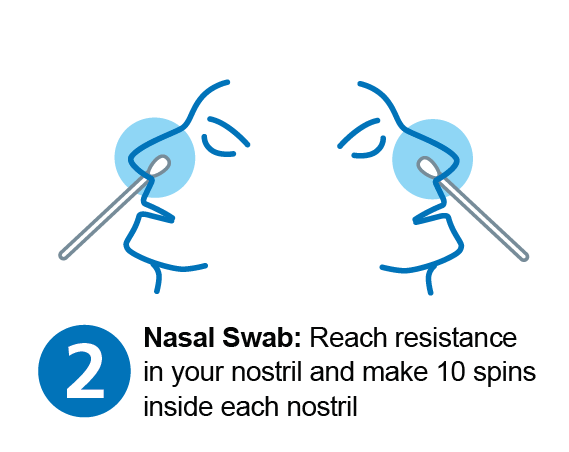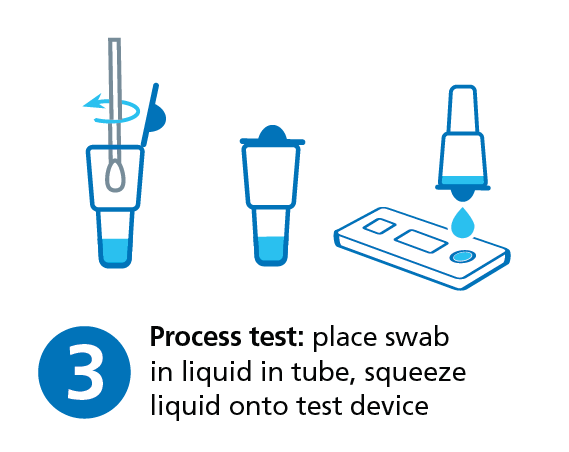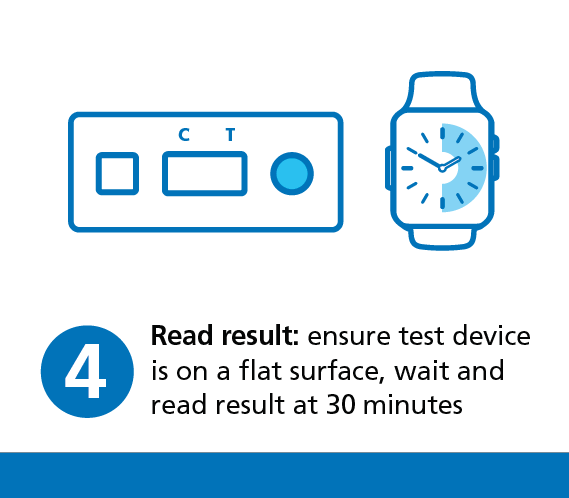Our programme of home-testing students for covid-19 begins this week, with the test kits coming home tomorrow. This post explains how the process will work.
After a huge effort, we’ve nearly completed our mass testing programme in school, with around 90% of students participating. It’s not the nicest activity, but our students have shown impressive maturity and responsibility in taking the tests, and we are grateful for the support of parents and staff. Now that the majority of students have had three lateral flow tests in school, we are able to move to home testing. Please read this information carefully to make sure you understand how to do the tests and how to report the results.
Why do these tests matter?
Up to one in three people who have COVID-19 can spread the virus without knowing. This is because they have no symptoms. To reduce the spread of the virus, we need to identify those individuals. We can do this by carrying out regular tests of everyone in school.
Students are being asked to do tests at home each Wednesday and Sunday evening, on a voluntary basis. However, as with the excellent take up rates of the in-school tests, we really hope that high numbers will take part, as widespread testing can really help us to reduce infections.
Please note: this does not replace symptomatic testing. If you have symptoms, you should self-isolate immediately, then book or order a PCR test and follow national guidelines.
How do we get the tests?
All students who have completed tests at school will be given home test kits on Thursday. Tests are free of charge. Students will receive four boxes, each containing three test kits with a leaflet on how to take the test and report the results to NHS Test and Trace. This is enough to cover everyone until after the Easter break.
As a parent of a child of school age you can also access at home testing kits for any member of your household. These can be ordered online.
We have also been advised by Calderdale Public Health that packs can be collected from the Asda Halifax Store testing site during any afternoon.
When and how do students take the tests?
Students should take the test twice per week and we would like students to regularly complete the test on a Sunday and Wednesday evening between 6pm-8pm to ensure an even spread across the week.
Students in Years 11, 12 & 13 - Because these students had their third in-school test on Monday 15 March, they should begin their home testing with a test this Thursday evening (18 March), before moving to regular Sunday/Wednesday tests. This is to ensure they keep the 3-5 day gap between tests.
All our Science classes have had a demonstration of how to use the self-test kits. Mr Sykes has produced the step by step video guide below to explain how to do the test. There is also a printed guide in each kit. Students can do the test using two nostrils (this is the technique completed in school) but can also do one nostril and a throat swab if preferred.
Self-Test Kit Demo video
Please ensure you carefully follow the instructions as the tests are much less effective if you do not - this includes waiting 30 minutes for the results.
There is no need to keep used test equipment after the test result has been reported. You can put it in your normal bin (household waste).
What should we do with the result?
For any result:
For a positive result also:
You need to report each test result (whether positive, negative or void) to the NHS. Once you have registered the first time, this is very quick. You will need the QR code or the number printed on the test.
In the event of a positive result, you must also inform school straightaway. This is really important. Please complete the form linked or contact school directly with the information requested and a member of our senior team will contact you to discuss the test result.
If your child tests positive then your child, household and any other close contacts must immediately self-isolate in line with NHS Test and Trace guidance. This will be for 10 days from the date of the test and the date will be confirmed by the Test and Trace website. You must also book or order a confirmatory PCR test - this is a different type of test for covid-19 and confirms the diagnosis.
If the result of the test is unclear (void) you should do another test.
A negative result does not guarantee that your child is not carrying the virus. You should continue to follow social distancing, and other measures to reduce transmission such as wearing a face mask and regularly washing your hands and observing social distancing.
If you or anyone in your household gets symptoms of the virus you should follow national guidelines on self-isolation and testing. You may be able to apply for a £500 Test and Trace Support payment to support you if you are unable to work because you have to self-isolate.
What happens if there is a positive case in school?
As part of our Test and Trace measures and in line with the guidelines to reduce the spread of infections, students who have been in close contact with a positive case will have to self isolate for 10 days (from contact). We will continue to operate our ‘bubble’ closures in the same way as we did last term.
In the case of a positive result from a home-test kit, we will ask students who have been in close contact to isolate until the outcome of the required PCR test is confirmed.
As we may receive results from a test during weekends or evenings, there may be occasions when we ask students to access remote learning for the following day, in order to enable us to identify the close contacts who need to self isolate.
All parents of students required to self isolate will be contacted via text message with a follow up email with dates once finalised. Please can we ask that all parents ensure all contact details are up to date. We’ll do our very best to keep you informed and up to date at all times.
Why take part?
Taking part in testing is voluntary and all students will be able to attend school whether they take part in testing or not. However, we do strongly encourage students to take part. Testing at home will allow your child and other students to attend school as safely as possible.
If you did not consent to the original testing programme in school, however you do now wish for your child to take part in the at home testing, then please email school at hometesting@rvhschool.co.uk and we will arrange for your child to be provided with a set of tests.
For more information, or if you have any questions or concerns, please see the FAQ below or contact your child’s Head of Year.
Thank you for your support.
+ Why is it needed?
Up to one in three people who have COVID-19 do not have symptoms and could pass on the virus without knowing. As we begin on our roadmap out of lockdown it is important we provide testing to identify potential outbreaks and help break the chains of transmission.
The asymptomatic testing expansion will help to break the chains of transmission of coronavirus (COVID-19) in education settings and the community by identifying asymptomatic positive cases.
Those who test positive will then self-isolate, helping to reduce transmission of the virus. The asymptomatic testing programme does not replace the Government’s current testing policy for those with symptoms. If any member of the household has symptoms of COVID-19 the whole household should self-isolate immediately and arrange a test for the symptomatic person.
+ Who is eligible?
This testing is available for secondary aged pupils, households and childcare or support bubbles of primary and secondary school age children. Students are expected to complete at least one test at school prior to the start of at home testing. This is to ensure that all students are competent at completing the test.
+ What type of tests will be used?
We will be sending home Lateral Flow Device (LFD) tests. They are a fast and simple way to test people who do not have symptoms of COVID-19, but who may still be spreading the virus.
The tests are easy to use and give results in 30 minutes.
+ How often do we need to test?
Secondary aged pupils are being asked to test twice a week. We would like you to test on a Sunday and Wednesday evening where possible.
+ How will we get our testing kits?
Secondary aged pupils will be given their test kits by their school after they have completed three tests within the school/college assisted testing site.
We are encouraging households and childcare/support bubble members to get asymptomatic tests twice a week, to support the school home testing kits programme.
+ Can my child take the test themselves?
Students aged 18 and over should do the test themselves and report the result, with help if they need it.
Students aged 12-17 should do the test themselves with adult supervision. The adult may help the child to take the test if they need support and the adult must report the result.
Students aged 11 must be tested by an adult and the adult must report the result.
+ My child or household members has a cough/fever/loss of smell or taste – should I use one of these tests to check if I/they have coronavirus?
No – Lateral Flow Testing Devices should not be used if you have any symptoms of coronavirus. Anyone who displays symptoms of coronavirus (COVID-19) can and should get a PCR test.
+ How reliable/effective are LFD kits used at home without a trained professional?
Lateral Flow Device (LFD) tests have been widely and successfully used to detect COVID-19 in asymptomatic individuals. Crucially, when levels of virus are at their highest and people are most likely to pass on the disease, lateral flow tests can detect the vast majority of cases.
No test is perfect, but the speed and convenience of LFD tests supports detection of the virus in asymptomatic individuals who would not otherwise be tested. Each positive case identified can help prevent many additional people becoming infected over time. LFD tests are crucial in the fight against the virus.
Extensive clinical evaluation has been carried out on the lateral flow tests. Evaluations from Public Health England and the University of Oxford show these tests are accurate and sensitive enough to be used by individuals in the community.
+ What about false negatives/positives?
All tests have false negatives and false positives to some degree. If an individual with a negative result goes on to develop symptoms, they must self-isolate and book a test as per the government guidelines.
LFD tests identify the most infectious individuals. These individuals tend to spread the virus to many people and so identifying them remains important. We believe the ability to self-test at home makes rapid testing even more convenient, accessible and further increases the speed at which people can self-isolate. It is important to remember that these tests are an additional health protection measure in addition to face coverings, social distancing, etc.
+ How are LFD tests different to PCR tests?
There are two main types of test to check if you have coronavirus:
- polymerase chain reaction (PCR) tests check for the genetic material (RNA) of the virus in the sample - you send the sample for processing at a lab
- lateral flow device (LFD) tests detect proteins called ‘antigens’ produced by the virus LFD tests give rapid results, in 30 minutes after taking the test.
+ Do I need to give consent?
Students and parents do not give written consent to take part in the home testing programme. Please read the information below on how personal information and test results are shared.
Once you open the kit you should take and report the results of the tests to NHS Test & Trace regardless of the result (positive, negative, or void).
+ Will there be a helpline/support for households and childcare/support bubble members?
People in England can call 119 (free from mobiles and landlines) - Lines are open every day, 7 am to 11 pm.
+ Reporting problems or issues with testing
If there is an issue with the test kit, for example something is missing, please report it by calling 119 and please also tell the school by emailing hometesting@rvhschool.co.uk.
If an accident or injury happens whilst using the test kit, please seek medical care by calling 111 (or 999 if it is an emergency). Please also report what happened using this website.
+ Do I need to send the test to a lab?
No. The LFDs supplied do not need to be sent to a laboratory to get a result and can give a quick result in around 30 minutes. Guidance on self-testing is found on the video.
+ Can I or someone else in my household use a test kit sent home from school?
No, however whole families and households with primary school, secondary school, and college age children, including childcare and support bubbles, will be able to test themselves twice every week from home. This testing can be accessed through the following channels:
- get a rapid test at work, through workplace testing. Ask your employer for more information.
- attend a test site to get tested where you will be able to see how to take the test or pick up tests to do at home (you can find your nearest test site via the postcode checker or check the local council website).
- collect tests to do at home, find your nearest collection site (Asda Halifax).
If these options are not possible, there will be a supply of rapid tests for order online for people who need them the most. More information can be found here.
Read more information available about testing for households and bubbles of students.
+ How will personal information and test results be shared?
When your child takes a Lateral Flow test, you need to report the result. This is so that their test result can be traced, which means that you need to share some information about your child.
You need to tell the Department for Health and Social Care (DHSC):
- your child’s name
- your child’s test result
- the reference number on the test Kit
You will also need to tell the school if their test result is positive.
Under UK law, the school can collect and store test result data because it is in the ‘public interest’.
This means that your child’s data helps us to stop the spread of the virus, and to keep your children in school. For example, we will tell your child to self-isolate if they get a positive test result.
We will only share information with the Department of Health and Social Care (DHSC) if the test kits used are found to be faulty. If this happens, DHSC will use our information to contact people who used the faulty tests, so that they can be tested again. This will ensure that testing is accurate and helps keep us all safe.
When you report test results online, you are sharing information with DHSC. They may share the information with your GP, local government, NHS, and Public Health England. This is so that they can offer your family health services and guidance if your child needs to self-isolate. They might also use your child’s data anonymously (without their name or contact information) to research COVID-19, and improve our understanding of the virus.







